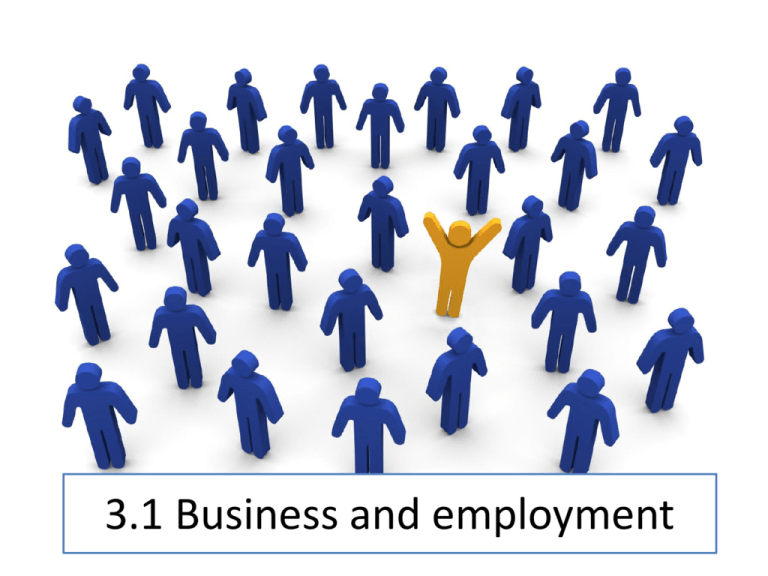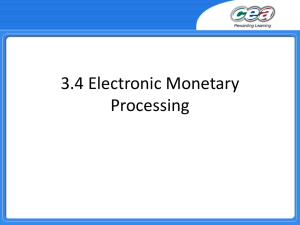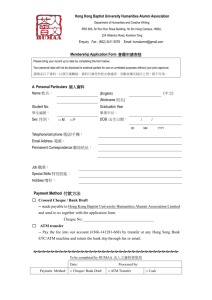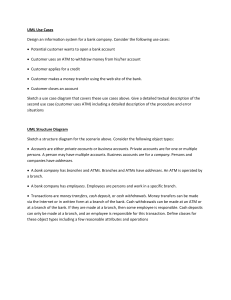3.1 Business and employment - OSC-ITGS
advertisement

3.1 Business and employment Banking and Finance Banking Applications Banks were one of the first business organisations to use computers and are usually at the cutting edge of new technology. Information Technology is used extensively in the Banking Sector where computer systems are used for Electronic Funds Transfer (EFT), Credit and Debit Cards, Cash Machines (ATM Cards), Cheque Clearance and Home Banking. Banks make use of a variety of different systems such as: • MICR (Magnetic Ink Character Recognition) • EFTPOS (Electronic funds transfer at point of sale) • EDI (Electronic data interchange) • EFT (Electronic fund transfer) • Credit Cards • Smart Cards • Cheque Clearing • BACS (Banker’s Automated Clearing Services) • ATM (Automated Teller Machines) MICR MICR MICR Magnetic Ink Characters use ink that contains iron and may be magnetised. The characters can then be read using special machines called Magnetic Ink Character Readers. When a cheque is printed the account number, branch code, and cheque number are all printed in magnetic ink. When cheques are cashed at a bank the bank also adds the amount onto the cheque using magnetic ink – The cheque can then be processed. Using magnetic ink protects the cheques from being changed and helps to prevent fraud. Electronic Funds Transfer EFT is a system that allows money transfer instructions to be sent directly to a bank’s computer system. Upon receiving one of these instructions, the computer system automatically transfers the specified amount from one account to another. Transfer instructions can come from other banks or from businesses. A very common use of EFT is when a large business pays its employees’ salaries. On pay day, the businesses tells the bank to move money from the business account to the employees’ bank accounts. EFTPOS When you use a bank card to pay for a purchase in a store, the payment is made using a system called Electronic Fund Transfer at Point-of-Sale (EFTPOS). 1 Customer gives the bank card to the cashier 2 The cashier runs the card through a card reader (the customer may have to enter a PIN). The cashier enters the value of the purchase 3 The store’s system then connects to the bank computer and sends a message 4 The bank computer uses the account number to access the customer’s record and checks the balance 5 The bank computer sends back a confirmation or rejection message to the store’s system 6 The cashier now confirms the purchase and an EFT message is sent to the bank 7 The bank computer subtracts $100 from the customer’s account and adds $100 to the store’s account 8 The cashier gives the card back to the customer along with a receipt ATM ATM Cash dispensers situated in banks, shopping centres etc. Some things that you can do using an ATM: • Get cash out • Find your account balance • Change your PIN number • Make deposits • Obtain a mini statement listing recent transactions ATM Benefits of ATM’s to Banks • Staff freed from routine work, so can concentrate on sales. • Fewer staff needed. • Can provide 24 hour service – therefore happier customers. • Customers cannot withdraw funds unless they have money in their accounts. Benefits of ATM’s to Customers • Some customers prefer the anonymous nature of the machine. • 24 hour service – ideal for those that cannot visit the bank during the day. • Ease of access to cash dispensers • Fewer queues as transactions performed by the ATM are fast. Using an ATM A customer identifies him/herself and their bank account by using a bank card. The card is inserted into the ATM where it is read by a magnetic strip reader or a smart card reader. The customer also types a secret PIN into the ATM's numeric keypad to confirm that they are the real owner of the card. ATMs can be used by customers of other banks as the ATM can use EFT. If a customer of Bank A uses her debit card to withdraw cash from an ATM belonging to Bank B: • Bank B gives her the cash • Bank B now is owed money by Bank A • Bank B sends an EFT instruction to Bank A asking for money to be transferred from the customer’s account to Bank B. • Bank B has now been paid back Internet Banking Today it is quite common to use communications links and the Internet for banking. This enables customers to log in securely to their bank. This on-line or e-banking service allows customers to access information about their account, transfer funds, pay bills, etc using a computer or telephone link from their home or office to the bank's system. Advantages of Home Banking • Convenience – Available 24/7 anywhere in the World. • Speed – Transactions are fast • Inexpensive Disdvantages of Home Banking • Risk of security breach/fraud • Impersonal – You don’t normally deal with bank staff • Requires you to have a computer HTTPS Customers use a computer and connect to the bank’s secure (encrypted) website where they login (usually with a username and a password) HTTPS The main idea of HTTPS is to create a secure channel over an insecure network. This ensures reasonable protection from eavesdroppers and man-in-the-middle attacks, provided that adequate cipher suites are used and that the server certificate is verified and trusted. The trust inherent in HTTPS is based on major certificate authorities that come preinstalled in browser software (this is equivalent to saying "I trust certificate authority (e.g. VeriSign/Microsoft/etc.) to tell me whom I should trust"). Therefore an HTTPS connection to a website can be trusted if and only if all of the following are true: 1. The user trusts that their browser software correctly implements HTTPS with correctly pre-installed certificate authorities. 2. The user trusts the certificate authority to vouch only for legitimate websites without misleading names. 3. The website provides a valid certificate, which means it was signed by a trusted authority. (an invalid certificate shows a warning in most browsers) 4. The certificate correctly identifies the website (e.g. visiting https://example and receiving a certificate for "Example Inc." and not anything else [see above]). 5. Either the intervening hops on the Internet are trustworthy, or the user trusts the protocol's encryption layer (TLS or SSL) is unbreakable by an eavesdropper. Chip and PIN PIN stands for Personal Identification Number. A PIN is usually a four digit secret code used to confirm a person’s identity (e.g. when withdrawing cash from an ATM) Note: You should not say ‘PIN number’ since that would mean ‘Personal ID Number number’! 'Chip & PIN' Payment System Most bankcards no longer rely on a magnetic strip to store customer account details. Instead the cards are smart cards. The cards contain a small amount of computer memory with the account information stored inside. Smart cards are more secure (since the data is encrypted) and more reliable than magnetic strip cards. When a customer wishes to pay for goods in a store, the customer inserts the bankcard into a smart card reader, and then types in a PIN to confirm that they are the true owner of the card. Once the PIN is verified, the customer can remove the card. One of the reasons this system has proven popular is the extra level of security it provides for users: At no time does the bankcard need to be handled by anyone other than the card owner, so with this system there is less chance of the card being stolen or copied. The nickname for the tiny memory device inside the bankcard is a ‘chip’, and the system uses a PIN as identity proof, so the system is nicknamed ‘Chip and PIN’ in the UK 3.1 Business and employment








